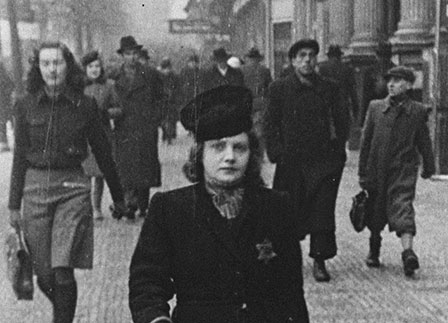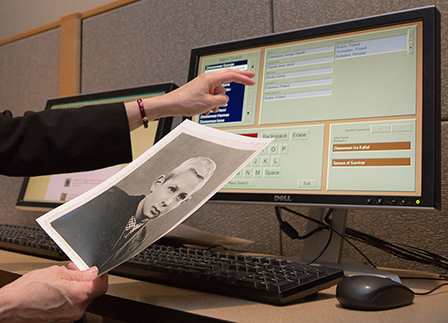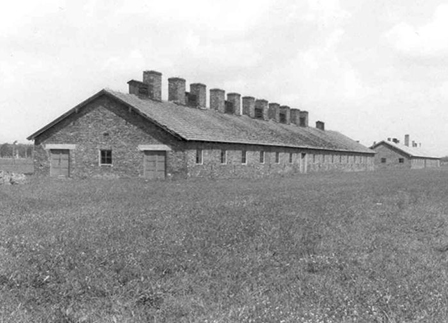- Caption
- Unidentified soldiers dusting survivors in Bergen Belsen with DDT powder to halt the spread of Typhus.
- Photographer
- Gwin
- Date
-
1945 April 28
- Locale
- Bergen-Belsen, [Prussian Hanover; Lower Saxony] Germany
- Photo Credit
- United States Holocaust Memorial Museum, courtesy of National Archives and Records Administration, College Park
- Event History
- Bergen-Belsen, near Hanover in northwest Germany, was established in March 1943 as a special camp for prominent Jews of belligerent and neutral states, who might be exchanged for German citizens interned abroad. Conditions in the camp were good by concentration camp standards, and most prisoners were not subjected to forced labor. However, beginning in the spring of 1944 the situation deteriorated rapidly. In March Belsen was redesignated an Ehrholungslager [Recovery Camp], where prisoners of other camps who were too sick to work were brought, though none received medical treatment. As the German Army retreated in the face of the advancing Allies, the concentration camps were evacuated and their prisoners sent to Belsen. The facilites in the camp were unable to accommodate the sudden influx of thousands of prisoners and all basic services -- food, water and sanitation -- collapsed, leading to the outbreak of disease. By April 1945 over 60,000 prisoners were incarcerated in Belsen in two camps located 1.5 miles apart. Camp No. 2 was opened only a few weeks before the liberation, on the site of a military hospital and barracks. Members of the British Royal Artillery 63rd Anti-Tank Regiment liberated Belsen on April 15 and arrested its commandant, Josef Kramer. The relief operation which followed was directed by Brigadier H. L. Glyn-Hughes, Deputy Director of Medical Services of the Second Army. Between April 18 and April 28, the dead were buried. At first the SS guards were made to collect and bury the bodies, but eventually the British had to resort to bulldozers to push the thousands of bodies into mass graves. Evacuation of the camp began on April 21. After being deloused inmates were transferred to Camp No. 2, which had been converted into a temporary hospital and rehabilitation camp. As each of the barracks was cleared they were burned down to combat the spread of typhus. On May 19 evacuation was completed and two days later the ceremonial burning of the last barracks brought to an end the first stage of the relief operations. Surviving Jewish DPs were transferred to Camp Three on May 21, 1945 from camps 1 and 2. By mid to late May, Bergen-Belsen assumed the status of a displaced person's camp. In July, 6,000 former inmates were taken by the Red Cross to Sweden for convalescence, while the rest remained in the newly-established DP camp to await repatriation or emigration.
Major General James Alexander Johnston of the Royal Army Medical Corps wrote a paper summarizing the medical situation in the newly liberated Bergen-Belsen concentration camp. The following is a summary of his article.
The 11th Armored Division of the British Army liberated Bergen-Belsen on April 15, 1945. Upon arrival, Bergen-Belsen was divided into two distinct camps. Camp I, frequently referred to as the "Horror Camp," housed approximately 22,000 females and 18,000 males. It had no running water or electricity, poor sanitation, limited clothing and infrequent and insufficient burial of the deceased. Camp II had less sickness, a lower death rate, more clothing, and better means for burial. Internees in both camps experienced severe cases of physical and mental sickness. An estimated 15,000 survivors suffered from typhus fever and nearly all suffered from diarrhea brought on by dysentery and starvation. Severe malnutrition reduced inmates to base survival instincts which, in some cases led to cannibalism. In an effort to limit further starvation, disease, and death, British units established four priorities: providing regular meals, preventing the spread of disease, removing survivors from the Camp I, and burying the deceased. Efforts to provide regular meals were hampered by limited mobility, limited staff, and the emaciated condition of the internees. Many suffered so severely from malnutrition that they were incapable of walking from their hut to a central food distribution center. However, limited staff impeded transporting food to the huts. At first, each hut designated a member to gather food and deliver it to the remaining inhabitants. Unfortunately, this system failed to equally distribute food. The presence of 11 Light Field Ambulances provided increased staff and alleviated some of the food supply problems by helping to equally distribute the food among the huts. Finally, due to prolonged periods of malnutrition, survivors good not digest normal rations. Some survivors could not even digest milk without first diluting it with water. Therefore three different dietary scales were created of 800, 1700, and 3000 calories until survivors could absorb a normal diet. To prevent the spread of typhus, the source of the virus first had to be identified. Although there was no cure for typhus, eliminating lice helped prevent the transfer of typhus from one individual to another. Therefore all clothing and huts of infected persons had to be either cleaned with delousing powder or burned to ensure that all of the lice were killed. The United States Typhus Control mechanically operated, multi point D.D.T. sprayer. Additionally, treating the effects of starvation enabled the internees to fight typhus if it was contracted. Before survivors could be removed from the Horror Camp, British troops had to prepare an alternate facility in the nearby Hohne Barracks. This entailed preparation and staffing of the reception building, removal of existing furniture, procurement of necessary furniture (i.e. hospital beds, etc.), organization and staffing of the wards, kitchens, stores, etc., and organizing a route from the Horror Camp to the Hohne Barracks. The task of clearing, cleaning and equipping the Hohne Barracks was carried on just ahead of the transfer of patients. Staffing problems were alleviated by using German prisoners of war including 35 medical officers, 130 nurses and 140 male orderlies. Before entering the Hohne Barracks, survivors were washed and deloused in a converted stable. The patients arrived to the stable via ambulance cars, then were placed upon tables and washed with hot water and soap, and finally dried and dusted with D.D.T. powder. Long, thick hair was initially cut off to ensure the elimination of lice, but later was dusted with D.D.T powder and retained due to the psychological impact of losing hair. Upon completion of this process, internees were placed upon clean stretchers and moved to the Hohne Barracks. This process was known as the 'human laundry.' Removal of the deceased proved to be a difficult task due to the sheer number of bodies and the lack of available personal. The remaining S.S. guards were assigned to this task and buried over 26,000 victims in two months. On April 21 when 300 the first patients relocated to the Hohne Barracks after first undergoing cleansing and delousing; eventually this number increased to 670 patients per day. The 11th Light Field Ambulance, assisted by the American Friends Ambulance Unit, a Quaker organization, handled the evacuation. At first, the internees in the camp were divided between those with serious cases of typhus and that recovering form typhus, designated by either a "T" or a "PT" on their forehead, dividing transportation based on physical health. Psychologically, this was difficult for the patients because it separated groups of people and relationships that were formed. Eventually, the process was changed to admitting patients upon the hut they were in to retain the personal attachments formed, although this did prove more difficult for the medical personal to treat the patients. In an effort to protect the staff, all were vaccinated against typhus and wore protective clothing. Of the twenty that contracted typhus, all of them fully recovered. Six detachments of the British Red Cross Society, composed of eight women assigned to the medical field and four men in the Military Government, and 97 British medical students arrived, supervised by the dietician Dr. R.A. Mmeiklejohn of N.N.R.R.A, arrived to help ward off starvation and improve upon conditions before the patients in Camp I to prepare for the transfer. This resulted in a decreased death rate and an increased morale as conditions improved. On April 28, more help arrived in the form of No. 9 British General Hospital, which were absorbed into the Hohne Barracks. On May 8, a second Field Ambulance No. 163 was used in the barrack hospital. On May 14, 35 British C.C.A. arrived and admitted 1600 internees. The last of the internees in the Horror Camp were evacuated on May 18. From the beginning of the evacuation, April 21 to May 18, 13,834 patients were admitted to the Hohne Barracks, 1844 died after admission. After this, the Horror camp was burned to prevent the spread of typhus.
[The complete report is filed in the Photo Archives with the Rosensaft provenance material.]
See https://encyclopedia.ushmm.org/content/en/article/bergen-belsen.
See Also "Bergen-Belsen Main Camp" in Encyclopedia of Camps and Ghettos, Volume 1 Part A.



